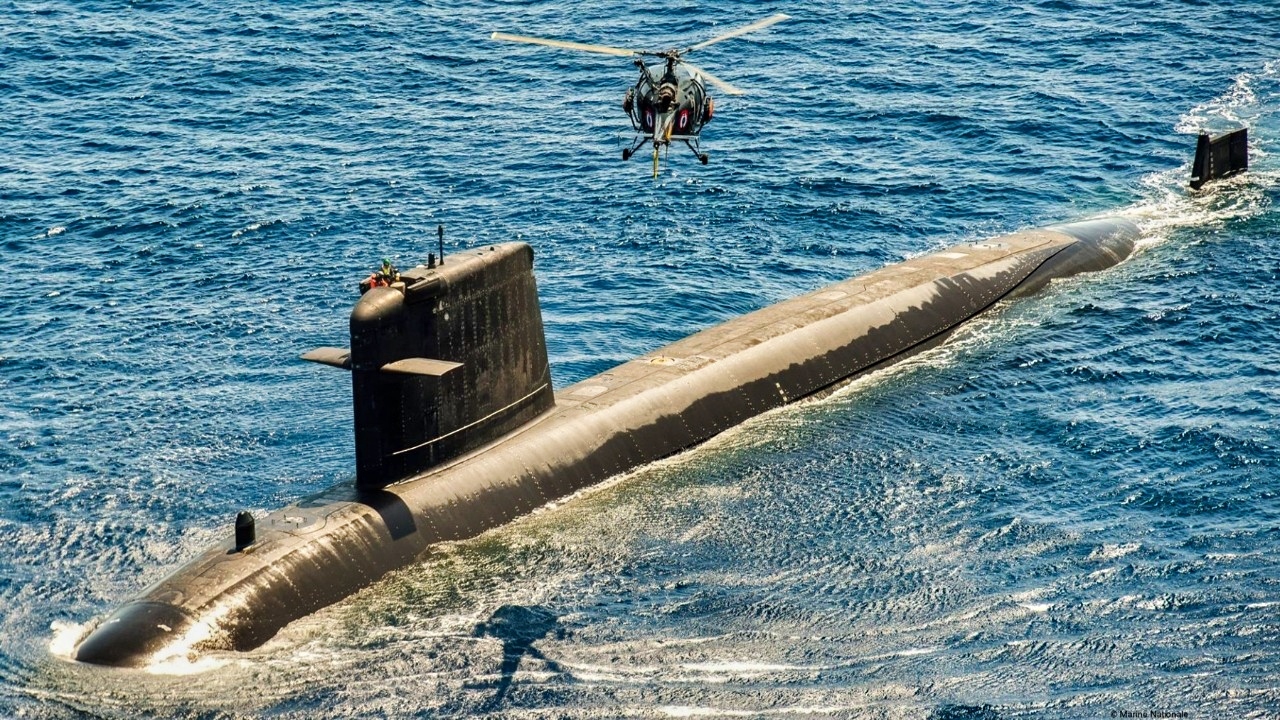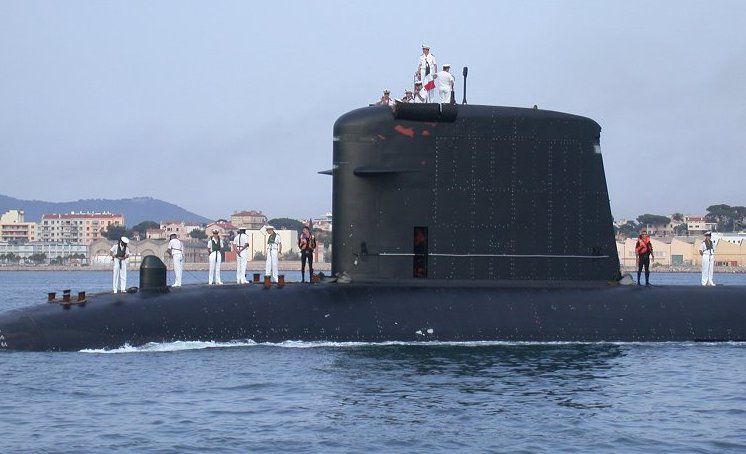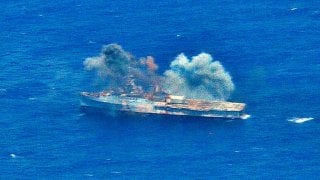$4,500,000,000 Nuclear Navy Aircraft Carrier 'Sunk' By Cheap French Sub
The USS Theodore Roosevelt, a $4.5 billion Nimitz-class aircraft carrier, was “sunk” in a 2015 war game by a comparatively inexpensive French Rubis-class submarine, the Saphir. This simulation underscored the vulnerability of even advanced and heavily funded systems to simpler, less costly weapons.
What You Need to Know: The USS Theodore Roosevelt, a $4.5 billion Nimitz-class aircraft carrier, was “sunk” in a 2015 war game by a comparatively inexpensive French Rubis-class submarine, the Saphir. This simulation underscored the vulnerability of even advanced and heavily funded systems to simpler, less costly weapons.

-Despite its vast capabilities and powerful escort ships, the Roosevelt failed to detect the Saphir, which executed a simulated successful strike.
-The exercise highlighted gaps in anti-submarine warfare and serves as a reminder that costly military assets aren’t invincible, and that lower-tech, inexpensive solutions can sometimes defeat even the most sophisticated systems.
Aircraft Carrier vs. Submarine: How a French Sub Exposed U.S. Navy Vulnerabilities
The aircraft carrier is a technological marvel, a piece of military hardware conferring status and prestige upon its owner like nothing else.
While the premise of an aircraft carrier is straightforward – a boat that launches and lands aircraft – the result is awesome: a boat that allows for the projection of air power from roughly any water-based location around the world.
And while the aircraft carrier premise is simple, the nuts and bolts of physically constructing such a vision can become complicated – and prohibitively expensive.
Yet, despite the awesome powers conferred from, and awesome monies invested in, aircraft carriers are still just a boat, susceptible to kinetic attacks and to sinking – as a joint Franco-US war game in 2015 suggested, when a Rubis-class submarine “sank” the USS Theodore Roosevelt aircraft carrier.
Aircraft Carrier: High expense does not confer invulnerability
The idea that a multi-billion dollar aircraft carrier may be existentially vulnerable to a relatively humble French submarine may seem shocking but it is consistent with a harsh reality of warfighting: high expense does not confer anything approaching invulnerability.
Sometimes, expensive systems aren’t even all that hardy at all. Examples abound.

During the Iraq War, low-budget, low-tech improvised explosive devices (IED) hampered US war fighting efforts, wreaking havoc upon expensive transportation equipment and well-outfitted troops. During the Soviet Invasion of Afghanistan, CIA-supplied shoulder launcher missiles downed dozens and dozens of Soviet helicopters. Defining the US presence in Somalia, two Blackhawk helicopters were downed in nearly immediate succession, thanks to rebel-fired RPGs – the premise for the book and film Blackhawk Down.
The fifth-generation F-22 Raptor, commonly regarded as the most advanced air superiority fighter ever constructed – with a sticker price costing multiple hundreds of millions – was flown over the Middle East in a limited way, which accounted for the airframe’s susceptibility to small arms fire. Think about that: a $200 million dollar aircraft deferring to a $100 firearm system. As far as air defense goes, that’s about as robust a return on your investment as you’re going to get.
At sea, the same principle applies. In the 1990s, one of Al Qaeda’s first attacks was off the coast of Yemen, when a fishing trawler loaded with basic explosives debilitated the USS Cole, a sophisticated US warship. Simple torpedoes and bombs have a long history of destroying multi-million dollar, many-years-in-the-making warships, from the Bismarck to the Arizona. The USS Theodore Roosevelt suffered a similar fate – albeit in theory, during a simulated wargame rather than in actual combat.
The sinking of the USS Theodore Roosevelt Aircraft Carrier
In 2015, the Saphir, a French Rubis-class submarine participated in a war game with US Carrier Strike Group 12. CSG-12 consisted of several Ticonderoga-class cruisers, Arleigh Burke-class destroyers, one Los Angeles-class stealth submarine, and of course, the USS Theodore Roosevelt.
The USS Theodore Roosevelt is a Nimitz-class nuclear-powered aircraft carrier. Price tag? $4.5 billion in 2007 dollars. Measuring over 1,000 feet long and carrying a complement of over 5,000 sailors and 90 aircraft, the Theodore Roosevelt was a floating city and a floating behemoth – one of the most advanced warships in the world.

The Saphir, by comparison, cost about 8,500,000 francs, a significant amount to be sure, but hardly the nearly nearly $5 billion invested upon the Theodore Roosevelt.
The war game, held off the coast of Florida, featured two distinct phases. In the first phase, the Saphir was integrated within the US Navy to assist with locating a hypothetical enemy submarine. During the second phase of the exercise, the Saphir was postured as the enemy submarine and tasked with locating and destroying the Theodore Roosevelt.
During the exercise, the humble Saphir successfully evaded the detection of the Roosevelt herself and her four escort ships. Then, the Saphir “sank” the Roosevelt, demonstrating concretely that a $5-billion investment was far from invulnerable.
The US Navy was embarrassed with the results, naturally, and attempted to scrub all related information from the internet. Autopsies of the exercise suggested that the Navy suffered from shortcomings in anti-submarine warfare capabilities – a fair conclusion after a submarine sinks one of your Navy’s crown jewel vessels.
The incident proved to be a cautionary tale and a humbling reminder that investing heavily in a system does not render said system invulnerable to attack. Sometimes, relatively simple and inexpensive systems can take down a much larger, sophisticated, and expensive piece of equipment.
About the Author: Harrison Kass
Harrison Kass is a defense and national security writer with over 1,000 total pieces on issues involving global affairs. An attorney, pilot, guitarist, and minor pro hockey player, Harrison joined the US Air Force as a Pilot Trainee but was medically discharged. Harrison holds a BA from Lake Forest College, a JD from the University of Oregon, and an MA from New York University. Harrison listens to Dokken.
All images are Creative Commons. The main image is from the SINKEX U.S. Navy drill this year. All others are of the Rubis-class submarine.


